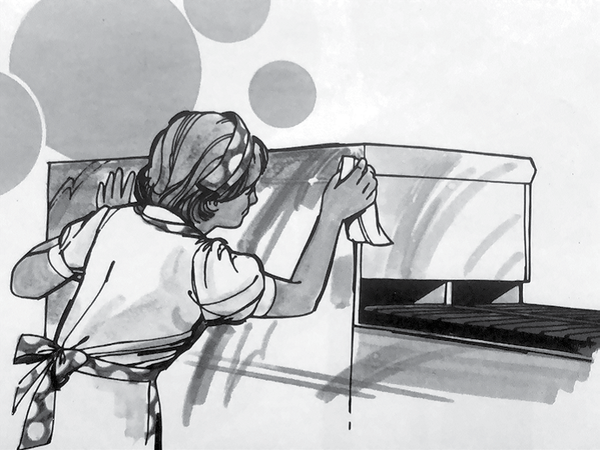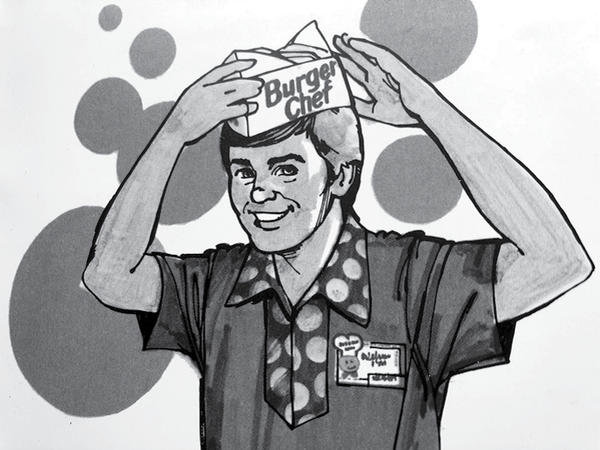This past November marked the 40th anniversary of the Burger Chef Murders, a series of killings in Speedway, Indiana. The victims, all under the age of 21, saw their lives cut short during what should have been a normal work shift. But what truly happened at the Burger Chef restaurant that night? In The Burger Chef Murders of Indiana, author Julie Young explores the case, and the tragic victims caught in the crosshairs. Read on to meet the victims, and learn about their last known moments at the Burger Chef.
The evening of November 17, 1978, was just like any other Friday night for the four young crew members closing the Burger Chef Restaurant at 5725 Crawfordsville Road in Speedway, Indiana. After serving up Big Shefs, Funmeals and other signature fare to their customers, the employees locked the doors at 11:00 p.m. and began to clean the store in preparation for the following day. Nothing seemed amiss as Daniel Davis, sixteen, changed out of his brown and orange uniform shirt in the restroom while his assistant manager, Jayne Friedt, twenty, took the cash from the register drawers and placed it in the safe located in the manager’s office.
Jayne’s career with the fast-food franchise began when she was a seventeen-year- old student at Avon High School. She started working for Burger Chef at the 38th Street and Lafayette Road location before transferring to the Speedway store in the spring of 1978. Everyone who encountered the longhaired dimpled young lady known as “Sweet Jayne” said she was a happy person who was always ready to tell or laugh at a joke.

“She had a zany smile that always reminded me of Lily Tomlin because when she smiled, her eyes would crinkle up into these crescent moon shapes,” said Lori Shufflebarger, who was a year behind Jayne in high school and frequently ate lunch with her at the same table in the cafeteria.
Jayne was a well-rounded individual who was involved in a number of activities while holding down her part-time job. She was involved with her school’s yearbook staff, concert band, choir, pep club, drama, gymnastics and more. She also served as a teacher’s aide and library assistant—supervisory positions that no doubt helped her succeed in the workplace. And although she took her managerial job seriously, she was a professional who had the ability to get beyond the small stuff in order to get her work done.
Like Jayne, Ruth Ellen Shelton, seventeen, was a poised and professional young lady who was in the fall of her junior year at Northwest High School. When she wasn’t clearing the “Works Bar” or wiping down Formica tables in the Burger Chef dining room after hours, she was an honor student who took the STEM-related classes that girls in the late 1970s typically shied away from. But Ruth Ellen was far from a typical teenager. That November, she was pursuing a double major in business and math in hopes that her heavy course load would help her get into a good college, where she planned to earn a degree in the emerging field of computer science.
Classmates said Ruth Ellen was a quiet, studious and creative girl, and when she was not working, hitting the books or engaging in her latest macramé project, she studied voice at Indiana Central University (today the University of Indianapolis) and was active in a variety of youth ministries at the Westside Church of the Nazarene.
“She often talked about how much fun she was having with her fellowship group,” Ruth Ellen’s mother, Rachel Shelton, said. “They were studying the Book of Revelation, and she was really fascinated by that.” Like other girls her age, Ruth Ellen alternately teased and mentored her younger siblings and kept a diary filled with the details of her life. The entry for December 25, 1977, recounted all of the gifts she received but concluded with the realization that she “learned how much she loved her mom and dad.”
When Rachel dropped Ruth Ellen off at the store on Friday afternoon, she paused in the parking lot to admire her little girl, who was growing into a beautiful young woman with her whole life in front of her. What a great time to be alive, she thought to herself, putting the car in reverse and pulling away.

Near the back of the store, Mark Flemmonds, sixteen, was cleaning the grill and hanging up his spatulas for the night. The youngest of seven children born to Robert and Blondell Flemmonds, Mark was raised in a devout Jehovah’s Witness household. Although Mark had some trouble adjusting to the rigors of high school and struggled throughout his freshman year, he rallied during the first months of the fall semester and was succeeding as a sophomore. Speedway High School officials were convinced that the friendly boy who took pride in his appearance would make it after all. His father was also encouraged by Mark’s scholastic improvement and allowed him to take a job at the Burger Chef, which was close enough to home that Mark could walk back and forth to work.
Daniel returned from the restroom and got to work bagging up the garbage before taking it out to the dumpster. He was a junior at Decatur Central High School who loved to laugh, tell jokes and have a good time. He was relatively new to the Friday night shift, having been moved to the closing crew after Speedway High School senior Diana Dillon left her position the week before.
Daniel had a passion for photography and often developed his pictures at home in his own darkroom. He was also fascinated with aviation and planned to enlist in the U.S. Air Force after high school. Like the other three, he was a model employee who never gave Gilyeat any trouble. In fact, the manager said all three of the students easily worked between twenty and thirty hours each week while maintaining their grades, and they had earned his trust. When he thought about it, he could not remember a time that any of them had been late for their shifts. They were truly an exceptional crew.
“They were kids who were out there trying to take responsibility,” Cherne said.
But that night, they were in the wrong place at the wrong time.

